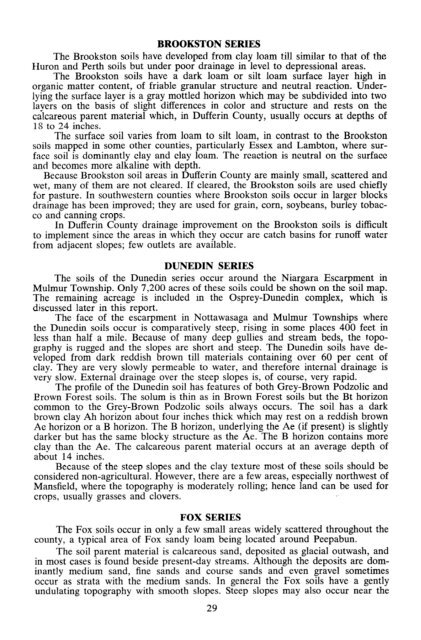Untitled - Agriculture and Agri-Food Canada
Untitled - Agriculture and Agri-Food Canada
Untitled - Agriculture and Agri-Food Canada
You also want an ePaper? Increase the reach of your titles
YUMPU automatically turns print PDFs into web optimized ePapers that Google loves.
BROOKSTON SERIES<br />
The Brookston soils have developed from clay loam till similar to that of the<br />
Huron <strong>and</strong> Perth soils but under poor drainage in level to depressional areas.<br />
The Brookston soils have a dark loam or silt loam surface layer high in<br />
organic matter content, of friable granular structure <strong>and</strong> neutral reaction. Underlying<br />
the surface layer is a gray mottled horizon which may be subdivided into two<br />
layers on the basis of slight differences in color <strong>and</strong> structure <strong>and</strong> rests on the<br />
calcareous parent material which, in Dufferin County, usually occurs at depths of<br />
1S to 24 inches.<br />
The surface soil varies from loam to silt loam, in contrast to the Brookston<br />
soils mapped in some other counties, particularly Essex <strong>and</strong> Lambton, where surface<br />
soil is dominantly clay <strong>and</strong> clay loam. The reaction is neutral on the surface<br />
<strong>and</strong> becomes more alkaline with depth.<br />
Because Brookston soil areas in Dufferin County are mainly small, scattered <strong>and</strong><br />
wet, many of them are not cleared. If cleared, the Brookston soils are used chiefly<br />
for pasture. In southwestern counties where Brookston soils occur in larger blocks<br />
drainage has been improved; they are used for grain, corn, soybeans, burley tobacco<br />
<strong>and</strong> canning crops.<br />
In Dufferin County drainage improvement on the Brookston soils is difficult<br />
to implement since the areas in which they occur are catch basins for runoff water<br />
from adjacent slopes; few outlets are available.<br />
DUNEDIN SERIES<br />
The soils of the Dunedin series occur around the Niargara Escarpment in<br />
Mulmur Township. Only 7,200 acres of these soils could be shown on the soil map.<br />
The remaining acreage is included m the Osprey-Dunedin complex, which is<br />
discussed later in this report.<br />
The face of the escarpment in Nottawasaga <strong>and</strong> Mulmur Townships where<br />
the Dunedin soils occur is comparatively steep, rising in some places 400 feet in<br />
less than half a mile. Because of many deep gullies <strong>and</strong> stream beds, the topography<br />
is rugged <strong>and</strong> the slopes are short <strong>and</strong> steep. The Dunedin soils have developed<br />
from dark reddish brown till materials containing over 60 per cent of<br />
clay. They are very slowly permeable to water, <strong>and</strong> therefore internal drainage is<br />
very slow. External drainage over the steep slopes is, of course, very rapid.<br />
The profile of the Dunedin soil has features of both Grey-Brown Podzolic <strong>and</strong><br />
Erown Forest soils. The solum is thin as in Brown Forest soils but the Bt horizon<br />
common to the Grey-Brown Podzolic soils always occurs. The soil has a dark<br />
brown clay Ah horizon about four inches thick which may rest on a reddish brown<br />
Ae horizon or a B horizon. The B horizon, underlying the Ae (if present) is slightly<br />
darker but has the same blocky structure as the Ae. The B horizon contains more<br />
clay than the Ae. The calcareous parent material occurs at an average depth of<br />
about 14 inches.<br />
Because of the steep slopes <strong>and</strong> the clay texture most of these soils should be<br />
considered non-agricultural. However, there are a few areas, especially northwest of<br />
Mansfield, where the topography is moderately rolling; hence l<strong>and</strong> can be used for<br />
crops, usually grasses <strong>and</strong> clovers.<br />
FOX SERIES<br />
The Fox soils occur in only a few small areas widely scattered throughout the<br />
county, a typical area of Fox s<strong>and</strong>y loam being located around Peepabun.<br />
The soil parent material is calcareous s<strong>and</strong>, deposited as glacial outwash, <strong>and</strong><br />
in most cases is found beside present-day streams. Although the deposits are dominantly<br />
medium s<strong>and</strong>, fine s<strong>and</strong>s <strong>and</strong> course s<strong>and</strong>s <strong>and</strong> even gravel sometimes<br />
occur as strata with the medium s<strong>and</strong>s. In general the Fox soils have a gently<br />
undulating topography with smooth slopes. Steep slopes may also occur near the<br />
29

















